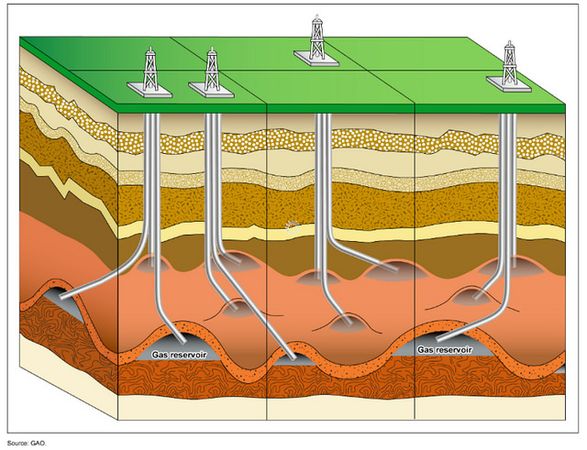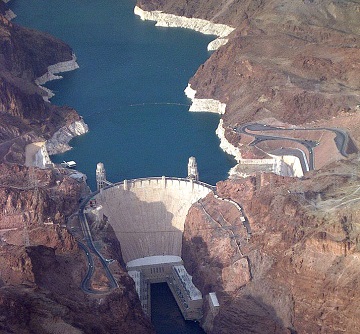Reservoir: Difference between revisions
m (1 revision imported) |
Energy>Jmdonev No edit summary |
||
| Line 1: | Line 1: | ||
[[category:371 topics]] | [[category:371 topics]] | ||
[[Category:Done | [[Category:Done 2020-01-31]] | ||
<onlyinclude>Places where [[fluid]]s collect are called '''reservoirs'''.</onlyinclude><ref>See for example the Oxford English Dictionary, oed.com accessed Aug. 21st, 2018.</ref> The most common fluids found in reservoirs are [[water]], [[hydrocarbon]]s, and [[gas]]. Reservoirs can be natural or artificial (human-made). Examples of natural reservoirs include hydrocarbon reservoirs in [[rock formation]]s (Figure 1) and water reservoirs that occur behind naturally occurring dams. Artificial dams mostly involve water, such as the reservoirs behind [[hydroelectric dam]]s (Figure 2).<ref>Petroleum Geology: Chapter 8 The Nature of Petroleum Reservoirs. R.E. Chapman, 1983, V.16. Accessed: Oct 7, 2018. Available from: https://www.sciencedirect.com/science/article/pii/S037673610870092X</ref> | <onlyinclude>Places where [[fluid]]s collect are called '''reservoirs'''.</onlyinclude><ref>See for example the Oxford English Dictionary, oed.com accessed Aug. 21st, 2018.</ref> The most common fluids found in reservoirs are [[water]], [[hydrocarbon]]s, and [[gas]]. Reservoirs can be natural or artificial (human-made). Examples of natural reservoirs include hydrocarbon reservoirs in [[rock formation]]s (Figure 1) and water reservoirs that occur behind naturally occurring dams. Artificial dams mostly involve water, such as the reservoirs behind [[hydroelectric dam]]s (Figure 2).<ref>Petroleum Geology: Chapter 8 The Nature of Petroleum Reservoirs. R.E. Chapman, 1983, V.16. Accessed: Oct 7, 2018. Available from: https://www.sciencedirect.com/science/article/pii/S037673610870092X</ref> | ||
Within [[energy | Within an [[energy]] context there are different types of reservoirs and the word reservoir can refer to: | ||
* [[Oil and gas reservoir|Reservoir - Oil and Gas]]: a formation of [[rock]] in which [[oil]] and [[natural gas]] has accumulated (Figure 1). | * [[Oil and gas reservoir|Reservoir - Oil and Gas]]: a formation of [[rock]] in which [[oil]] and [[natural gas]] has accumulated (Figure 1). | ||
* [[Water reservoir|Reservoir - Water]]: a human made structure that stores water in a defined volumetric area, most specifically a [[hydroelectric reservoir]] (Figure 2). | * [[Water reservoir|Reservoir - Water]]: a human made structure that stores water in a defined volumetric area, most specifically a [[hydroelectric reservoir]] (Figure 2). | ||
Revision as of 21:49, 16 January 2020
Places where fluids collect are called reservoirs.[1] The most common fluids found in reservoirs are water, hydrocarbons, and gas. Reservoirs can be natural or artificial (human-made). Examples of natural reservoirs include hydrocarbon reservoirs in rock formations (Figure 1) and water reservoirs that occur behind naturally occurring dams. Artificial dams mostly involve water, such as the reservoirs behind hydroelectric dams (Figure 2).[2]
Within an energy context there are different types of reservoirs and the word reservoir can refer to:
- Reservoir - Oil and Gas: a formation of rock in which oil and natural gas has accumulated (Figure 1).
- Reservoir - Water: a human made structure that stores water in a defined volumetric area, most specifically a hydroelectric reservoir (Figure 2).
- Natural gas storage: extracted natural gas is sometimes injected into depleted reservoirs, either for storage or to increase the pressure in the reservoir to make extraction of other substances easier.
- Reservoir Examples
Figure 1. Gas reservoirs are located deep underground.[3]
Figure 2. The reservoir behind the Hoover Dam is called Lake Mead.[4]
For Further Reading
- Oil and gas reservoir
- Water reservoir
- Hydroelectric reservoir
- Oil
- Gas
- Water
- Or explore a random page
References
- ↑ See for example the Oxford English Dictionary, oed.com accessed Aug. 21st, 2018.
- ↑ Petroleum Geology: Chapter 8 The Nature of Petroleum Reservoirs. R.E. Chapman, 1983, V.16. Accessed: Oct 7, 2018. Available from: https://www.sciencedirect.com/science/article/pii/S037673610870092X
- ↑ "Example of a Multiple Lease Unit with Wells Developing a Conventional Gas Reservoir", Flickr, 2018. [Online]. Available: https://www.flickr.com/photos/usgao/13985529318. [Accessed: 15- Aug- 2018].
- ↑ Wikimedia Commons. (September 1, 2015). Hoover Dam [Online]. Available: https://upload.wikimedia.org/wikipedia/commons/d/d8/Hoover_Dam_Nevada_Luftaufnahme.jpg



